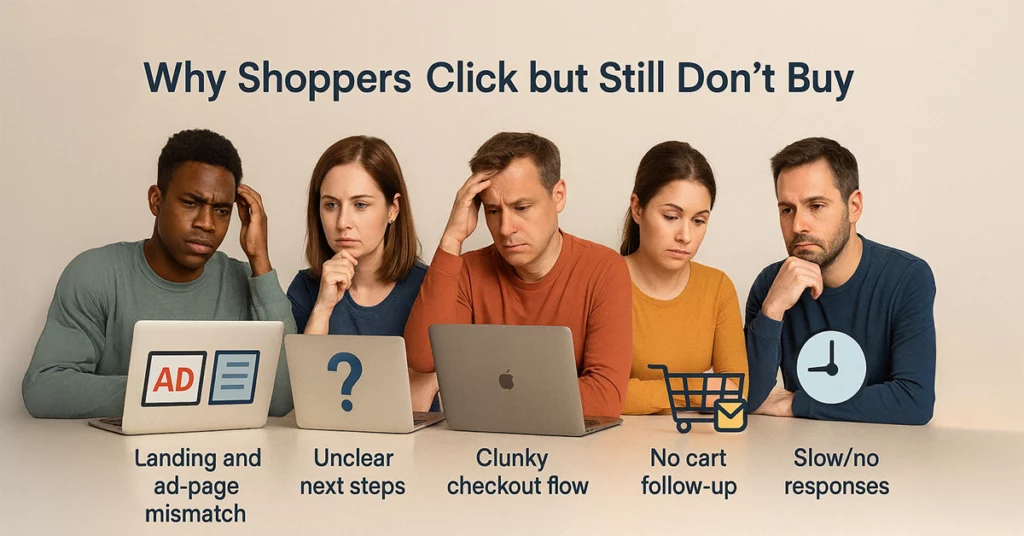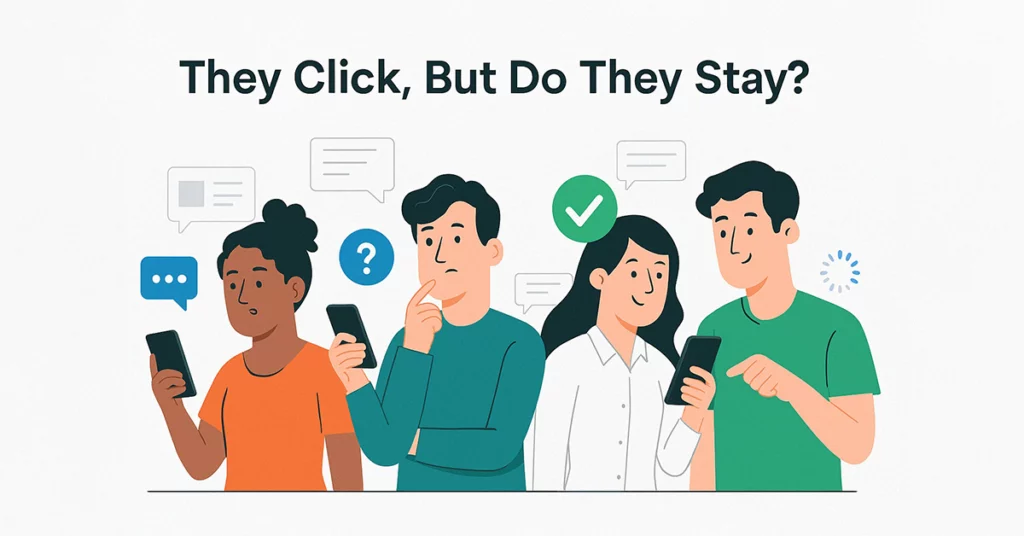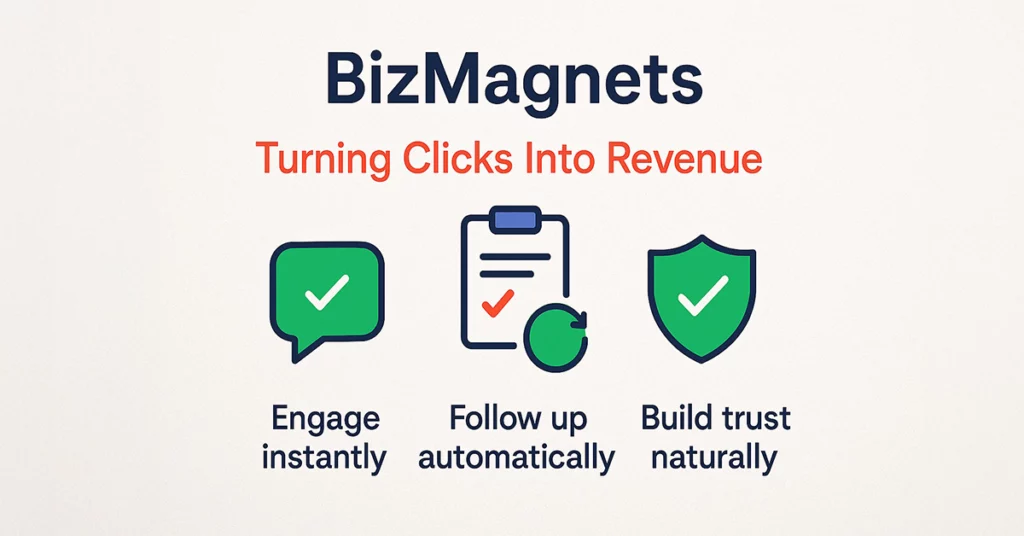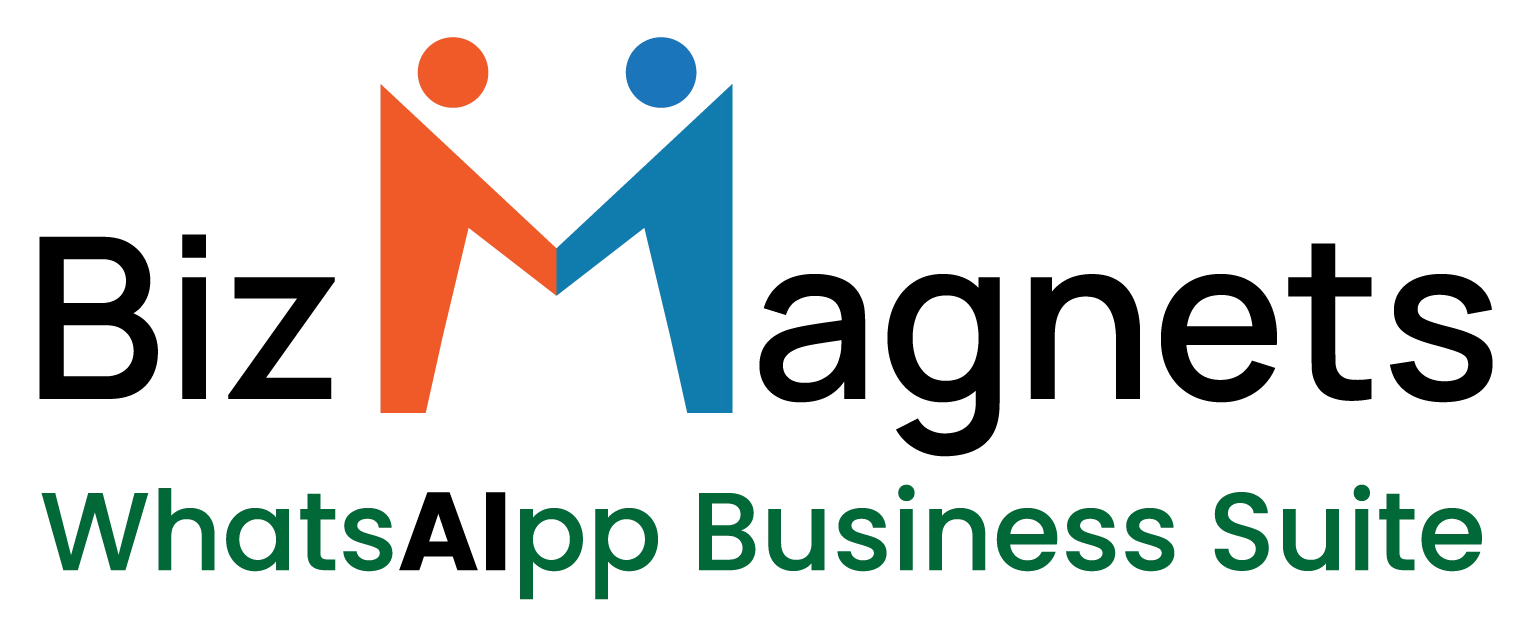Experience the Power of WhatsApp Automation
You’re spending more money on ads.
More people are seeing your brand.
Lots of them are clicking your ads.
But not many are buying.
If you’ve been wondering why your campaigns look great on paper but aren’t converting, you’re not alone. Many businesses face this frustrating disconnect, investing more in ads and still not seeing a rise in revenue. The gap between traffic and transactions isn’t always about targeting or spending. It often lies somewhere you may not be looking closely enough.
Let’s explore that.
Why People Click But Don’t Buy?
Most growth problems don’t start at the top of the funnel, they start after the click.
We assume that once someone clicks on our ad, they’ll naturally flow into becoming a customer. But this assumption is what leads to silent losses.
Think of your website as a physical store. You put up a banner outside to draw people in, your ad. But once they enter, if the experience is confusing, unwelcoming, or lacking assistance, they’ll walk right back out.
That’s what happens digitally when there’s no post-click strategy.
Common Drop-Off Points You Might Be Overlooking

Sometimes the problem isn’t your ad, it’s what happens after someone clicks. Here are a few common drop-off points that silently kill conversions, along with examples to illustrate what this looks like in action:
- The landing page doesn’t align with the ad’s promise
- There’s no clarity on what to do next
- The checkout process feels slow or overly complicated
- Cart abandoners aren’t followed up with
- Questions go unanswered, or response times are delayed
1. The Landing Page Doesn’t Align With the Ad’s Promise
Example: An ad says: “Flat 50% Off on First-Time Orders – Shop Summer Dresses Now.”
But when users click, they land on a generic homepage filled with winter collections and no mention of the offer.
Result: The user feels misled and drops off within seconds.
- There’s No Clarity on What to Do Next
Example: A user clicks on a webinar ad titled “Learn SEO in 30 Minutes – Free Live Session.”
The landing page talks about SEO tools but doesn’t clearly show how to register, what the date is, or what to expect.
Result: They get confused, scroll aimlessly, and exit without signing up.
- The Checkout Process Feels Slow or Overly Complicated
Example: An e-commerce shopper adds a product to their cart. But at checkout, they’re asked to create an account, verify their email, enter their address twice, and go through 3 payment pages.
Result: They abandon the cart out of frustration.
- Cart Abandoners Aren’t Followed Up With
Example: Someone adds a ₹2,000 skincare combo to their cart, reaches the payment page but gets distracted. No reminders, no gentle nudge, no offer to bring them back.
Result: The intent fades, and they forget.
Now imagine if they had received a WhatsApp message an hour later:
“Still thinking about our Glow Combo? Here’s 10% off — just for you.”
That could have saved the sale.
- Questions Go Unanswered or Response Times Are Delayed
Example: A customer visits your page, interested in a high-value product, and sends a message:
“Hi, can this be shipped by Friday?”
Your support team responds 18 hours later.
Result: The customer already ordered from someone else who replied in 3 minutes.
Now imagine having an auto-response:
“Hey! We’ve received your query. While our team checks, here’s our shipping guide for urgent deliveries.”
Even that small gesture would’ve kept them engaged.
In all these cases, it’s not the ad that failed, it’s the experience that followed. What businesses really face isn’t a traffic problem but an engagement problem.
They Click, But Do They Stay?
It’s easy to get someone to click. The real challenge is what you do with that attention.
Modern consumers expect more than just a good-looking landing page. They want fast, relevant communication. They want help when they hesitate. They want to feel like someone’s actually paying attention.

Especially on mobile, where every second counts and distractions are everywhere. If your funnel isn’t responsive, personal, and built for conversations, users will simply move on.
So, What Happens After the Click?
Let’s walk through a few real-world scenarios.
Scenario 1: Skincare Brand
A user clicks an ad promising a 7-day glow product. They land on a site filled with similar products, with no guidance and a generic layout. Confused, they leave.
Scenario 2: Online Course Platform
A potential learner adds a course to their cart. Life gets busy, and they forget. No reminder, no follow-up. That intent is lost.
Scenario 3: SaaS Company
Someone fills out a demo form at 4:30 PM. The sales team responds the next day. In the meantime, the lead booked a demo with a competitor who replied within minutes.
In all three cases, the business got the click but lost the customer.
The Right Way to Guide Your Shoppers
Now, imagine a funnel where engagement is timely and automated but still personal.
Skincare Example:
Instead of dropping users on a crowded product page, they receive a message:
“We saw you were checking out our 7-Day Glow Kit. Need help finding the right option for your skin type?”
Course Example:
The user who abandoned their cart gets a gentle reminder:
“You left the UX Design course in your cart. Here’s a limited-time discount in case you want to complete your enrollment.”
SaaS Example:
As soon as the lead fills out the form, they get an instant response:
“Thanks for reaching out. While our team prepares your demo, feel free to ask any questions here.”
These are small actions, but they make a significant difference.
Why Conversations Work Better Than Campaigns
“Traditional campaigns push messages.
Conversations invite responses.”
When you treat your marketing funnel as a two-way interaction instead of a one-way broadcast, everything becomes more effective. People don’t just want to see ads, they want to explore, ask questions, and feel heard.
Remember, it’s not about hiring more people or staying online 24/7. It’s about setting up smart, automated systems that naturally engage your leads, right where they already are, like on WhatsApp.
A Smarter Way to Convert Traffic into Sales
With platforms like BizMagnets, businesses are automating follow-ups, answering FAQs instantly, reminding users about abandoned carts, and even sending personalized offers, all through a single conversation thread.
It’s not just about responding. It’s about showing up at the right moment, when the interest is fresh and the intent is high.
Here’s what you can implement with BizMagnets:
- Welcome messages after ad clicks
- Product suggestions based on ad content
- Abandoned cart reminders with offers
- Follow-up flows after form submissions
- Customer support via chat, not emails
The best part? You don’t need to change your ad strategy. You just need to build better bridges between the click and the sale.
Before You Scale Your Ad Budget, Ask This
Every click is an opportunity.
Every visit is a signal of interest.
But without timely engagement, these moments are wasted.
So before increasing your ad spend again, ask yourself:
- Do we respond quickly enough to inbound leads?
- Are we engaging users who show buying signals?
- Is our post-click journey as strong as our ad creative?
If not, the solution isn’t more ads. It’s a better follow-up system.
BizMagnets: Turning Clicks Into Revenue

At BizMagnets, we help businesses convert curiosity into action using WhatsApp automation. Whether you’re in e-commerce, SaaS, education, or services, the post-click journey is where real results begin.
Our tools help you:
- Engage instantly
- Follow up automatically
- Build trust naturally
With the same ad budget, you can achieve more just by fixing the broken middle.
Conclusion
“Don’t Just Chase Clicks. Build Conversations.”
Blog Outline
-
Why People Click But Don’t Buy?Why People Click But Don’t Buy?
-
Common Drop-Off PointsCommon Drop-Off Points
-
The Right Way to Guide Your ShoppersThe Right Way to Guide Your Shoppers
-
Why Conversations Work Better Than CampaignsWhy Conversations Work Better Than Campaigns
-
BizMagnets: Turning Clicks Into RevenueBizMagnets: Turning Clicks Into Revenue



